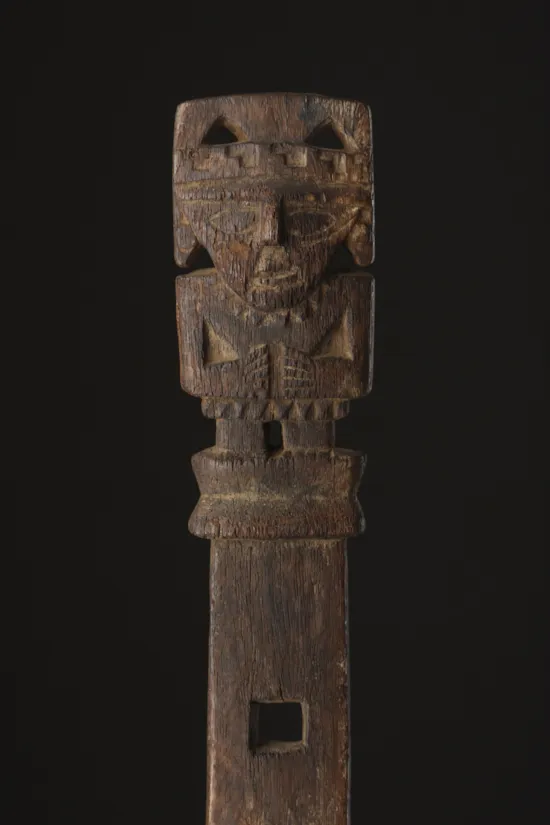Pre-Columbian Peruvian Uprights
Pre-Columbian Peruvian Uprights
a
A Pair of Pre-Columbian Peruvian Chancay Wooden Uprights from a litter each surmounted with a crouching cat probably representing a puma
Central Coast
Circa 900 – 1450AD
Size: 44.5cm high – 17½ ins high (each)
b
A Pre-Columbian Peruvian Chancay Wooden Weaving Pin
Surmounted with a seated human figure
Central Coast
Circa 900 – 1450AD
Size: 38cm high – 15 ins high
c
A Pre-Columbian Peruvian Chimú Carved Wood Upright from a litter surmounted with an upright figure of a ritual bearer
North Coast
Circa 1100 – 1450AD
Size: 93cm high – 36½ ins high
d
A Pre-Columbian Peruvian Chimú Carved Wood Upright from a litter surmounted with a standing figure of a ritual bearer
North Coast
Circa 1100 – 1450AD
Size: 86.5cm high – 34 ins high
a
A Pair of Pre-Columbian Peruvian Chancay Wooden Uprights from a litter each surmounted with a crouching cat probably representing a puma
Central Coast
Circa 900 – 1450AD
Size: 44.5cm high – 17½ ins high (each)
b
A Pre-Columbian Peruvian Chancay Wooden Weaving Pin
Surmounted with a seated human figure
Central Coast
Circa 900 – 1450AD
Size: 38cm high – 15 ins high
c
A Pre-Columbian Peruvian Chimú Carved Wood Upright from a litter surmounted with an upright figure of a ritual bearer
North Coast
Circa 1100 – 1450AD
Size: 93cm high – 36½ ins high
d
A Pre-Columbian Peruvian Chimú Carved Wood Upright from a litter surmounted with a standing figure of a ritual bearer
North Coast
Circa 1100 – 1450AD
Size: 86.5cm high – 34 ins high
Trees were relatively rare along the Peruvian seaboard and so the most significant ritual objects of these coastal dwellers were made of wood. Until recently one of the oldest objects known in wood was the fragment of a litter discovered in the 1980's during excavations at La Galgada. The site had been occupied from 3000 to 1500BC and consisted of two circular ceremonial units each containing several chambers. The litter was made of five slats of wood set side to side and was found in a partially looted tomb.
The position of litter-bearer seems to have played an important role in Pre-Columbian Peruvian society. Under the rule of the Incas, the bearers were chosen only from among the Chacapoyas, a group from the eastern slopes of the Andes in the north. The number of these statuettes illustrating the bearer’s position, their link to power, ritual and burial ceremonies indicates the importance of their role.
Weaving and the textile arts of ancient Peru had a fundamental influence on virtually all the artistic creations of Pre-Columbian Peruvian cultures. The stylistic study of wood and stone sculpture and even ceramic modelling has shown that concepts of plastic art arose from creations conceived in two dimensions by weavers.
The position of litter-bearer seems to have played an important role in Pre-Columbian Peruvian society. Under the rule of the Incas, the bearers were chosen only from among the Chacapoyas, a group from the eastern slopes of the Andes in the north. The number of these statuettes illustrating the bearer’s position, their link to power, ritual and burial ceremonies indicates the importance of their role.
Weaving and the textile arts of ancient Peru had a fundamental influence on virtually all the artistic creations of Pre-Columbian Peruvian cultures. The stylistic study of wood and stone sculpture and even ceramic modelling has shown that concepts of plastic art arose from creations conceived in two dimensions by weavers.
Pre-Columbian Peruvian Uprights

SOLD
















